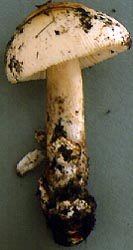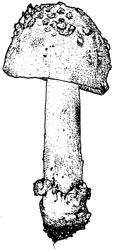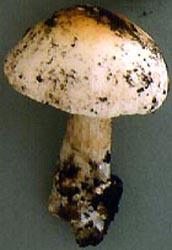|
[ Section Vaginatae page. ] [ Amanita Studies home. ] [ Keys & Checklist/Picturebooks ] Amanita populiphila Tulloss & E. Moses"Cottonwood Ringless Amanita"
Technical description (t.b.d.) BRIEF DESCRIPTION: This species was originally described by Tulloss and E. Moses (1995<). Amanita populiphila has a cap 30 - 120 (-135) mm wide that is white to off-white to pale tan or pale cream at first and becomes pale yellowish to straw-color to tan to brown with age and handling. It is broadly campanulate at first, then convex and broadly umbonate, and finally plano-convex in age with its margin uplifted. The flesh is 5 - 12.5 mm thick over the stem and is pure white, unchanging with cutting or bruising. The cap margin is striate (about 15% of the radius at first, becoming 20% to 40% of the radius).The volva may be absent or present as warts, small patches, or a single patch with extensive cracking on its surface. The volva is white at first and tends to change in color as the cap does (even occasionally becoming significantly darker than the cap); it is fragile, and easily removed. The gills of this species are free or narrowly attached, sometimes leaving very pallid orange vertical lines on the upper stipe; they are close to crowded and off-white to cream with pale orangish or pinkish tints in mass. In side view, the gills are white to various shades of cream and do not change when cut or bruised. Just after drying they are often a pale shade of pink or orange. They are 3 - 7.5 mm wide and have flocculence on the edge that ranges from concolorous to pale orangish white. Short gills are truncate to excavate-truncate, in several ranks, unevenly distributed, and common to plentiful. The stem of A. populiphila is 63 - 175 (-220) x (5-) 7 - 20 mm, white (sometimes with pale watery streaks), sometimes becoming pale watery brown after handling (but often not changing), and exannulate. The flesh is white to off-white and usually unchanging when cut or bruised (concolorous in tunnels made by insect larvae). There is a hollow central cylinder 2.5 - 14 mm wide. The volva is white (with color changes as on the cap) and more cup-shaped than sac-shaped. It is weakly structured and may break up into warts or patches on the lower stipe or simply come off the stem entirely during collecting (like a thimble) unless carefully excavated with the stem base. Amanita populiphila has a mild or insignificant odor at first that may become pungent in older specimens. The Moses family has eaten and enjoyed this species, they say the taste is mild and "pleasantly fungoid" except for the tasteless volva; and, in their preparation, the stem was "pleasantly crispy." The spores of this species measure (7.0-) 9.2 - 12.5 (-21) x (6.0-) 8.2 - 11.2 (-15.8) µm and are predominantly subglobose (occasionally globose or broadly ellipsoid) and inamyloid. Clamps are not found at the bases of basidia. Amanita populiphila wasm first found under Cottonwood and Aspen (Populus) in the central and western USA -- from Michigan and Kansas westward to Idaho, Wyoming, Colorado, and New Mexico. In 2008, a collection of this species (again found under Populus) was sent to me by Renée Lebeuf from Prov. Québec, Canada. This is the most easterly known site for the species at present. This species was distinguished in detail from A. nivalis Grev. and A. vaginata var. alba Gillet in its original description. -- R. E. Tulloss Photo: R. E. Tulloss (ca. Angel Fire, New Mexico, USA) [ Section Vaginatae page. ] [ Amanita Studies home. ] [ Keys & Checklist/Picturebooks ] Last changed 25 September 2009 |



